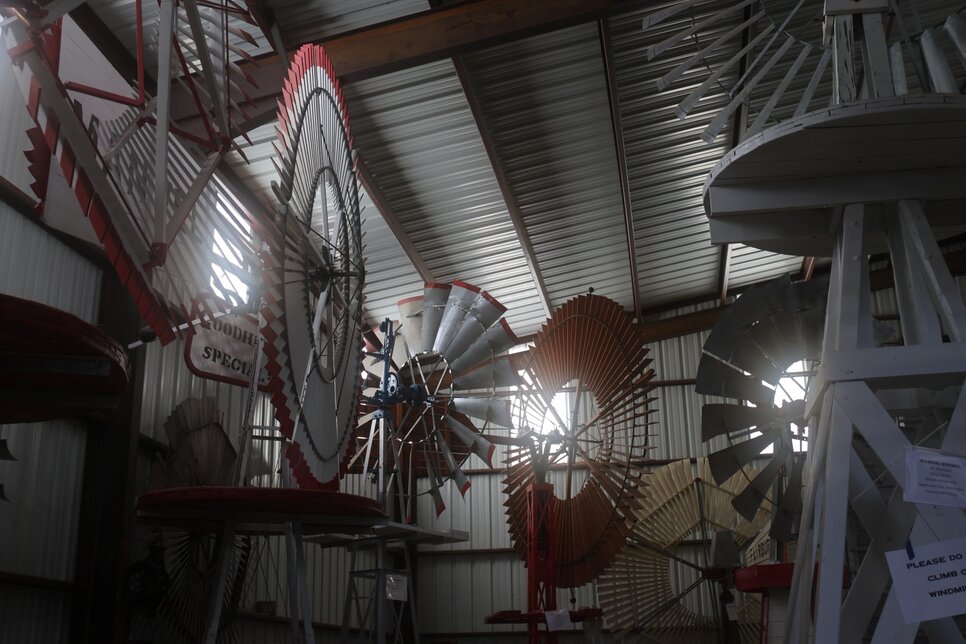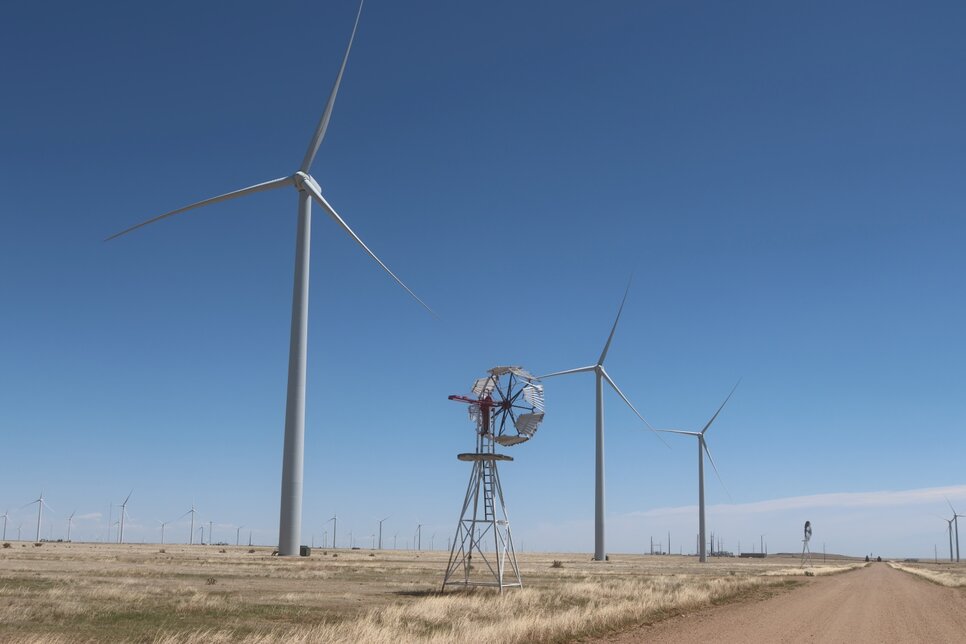The past, present and future of windmills converge in Lamar, Colorado
share

LAMAR, Colo. — A legion of towering wind turbines punctuate the horizon outside of the Emick family’s barn. Inside the barn is a menagerie of the turbine’s forebears: windmills.
The family’s 9,000-square-foot barn is brimming with antique windmills constructed from cypress and galvanized steel. Some are more than a century old, sporting historically accurate paint jobs.
The Emicks, ranchers by trade and “windmillers” by choice, have one of the largest private windmill collections in the United States on their ranch about 30 miles south of Lamar’s main street.
Bob Emick, 93, first became interested in collecting and restoring these relics of frontier life after discovering a photo of the family’s original homestead. It shows an original wooden Eclipse windmill built by the Fairbanks Morse Company to the left of the house.
The windmill, and the original homestead structure, still stand today.
“I thought, ‘Gee, it’d be nice to restore that thing and put it back to where it was,’” Bob Emick said. “And so that’s what got us started.”
Established in 1918, the homestead first belonged to Bob Emick’s aunt, Elizabeth Hasser. The photo the Emicks discovered was likely taken in the early 1920s.
Bob Emick and his wife, Helen, wished to find the actual windmill in the photo and restore it. That Eclipse, though, was lost to history, so in 1982 — 27 years after the couple first moved to Hasser’s ranch — Bob and Helen found an identical Eclipse windmill on another ranch and restored that one instead.

“And then, that was the start of it,” said the couple’s son, Kenneth Emick. “We got into car collecting, only windmills.”
Three or four years after restoring the initial Eclipse windmill, the Emicks restored another. And then another, and another — the cycle repeated itself, like the fan of a windmill spinning round and round.
The Emick’s collection quickly approached 50 windmills. In the late 90s, the family sold about 40 of them to the American Wind Power Center, a museum in Lubbock, Texas.
“We’ve probably got about 70 mills scattered across the United States,” Kenneth Emick said, “from Lubbock, Texas to Batavia, Illinois [and] Nebraska, Colorado, South Carolina.”

Today, the family retains about 45 antique windmills in their barn, which functions as a museum of sorts. Each windmill has a placard with information about its history. Windmillers have traveled from across the country to visit the barn, and Helen Emick has the guest book to prove it.
That figure has increased in recent years — it was 23% in 2020 — and could continue to rise. The Colorado Sun reported in 2022 on the “big land rush” of international companies working to establish wind farms in Colorado.
“There was always somebody calling and wanting to come buy or trade or just learn from Bob,” she said.
“We’ve probably restored about 125 to 140 windmills all together,” Bob Emick said. “There used to be a panoramic view outside of windmills, all away around this ranch.”
Now, that view is different. Turning off Highway 385 onto County Road East toward the Emick’s ranch, one must drive through an orchard of soaring wind turbines measuring over 400 feet tall, including the rotors.
The Colorado Green Wind Project operates nearly 100 turbines on the Emick’s land. When it became operational in January of 2004, the project was the fifth-largest wind farm in the United States. The electricity generated by the turbines is sold to Xcel Energy, and the Emicks receive royalties and a fee for each turbine.
Colorado is one the largest natural gas and crude oil-producing states in the nation. However, the state is also responsible for a tremendous amount of wind energy. In 2022, wind turbines produced 28% of Colorado’s energy, according to the latest land-based wind market report from the U.S. Department of Energy.

Humans have been harnessing wind power for nearly as long as they have been recording history. The first documented uses of wind power occurred on the Nile River circa 5,000 BC, where ancient Egyptians used wind to move boats.
Thousands of years later, during the Han dynasty (around 200 BC), the Chinese used wind-powered water pumps. Wind energy was also used to grind grain in Persia and the Middle East around the same time.
The history of wind power in the United States, meanwhile, is far more recent. In 1854, Daniel Halladay patented the first self-governing windmill, meaning the windmill turned into the wind on its own and could control its speed so that severe weather wouldn’t destroy the machine.
Early windmills in the United States were almost exclusively used to pump water. “Windmills were often among a homesteader’s most prized possessions,” according to the National Park Service. “The water pumped by windmills was used to cook, bathe, drink, water crops and animals, wash clothes, and more. These mills were simple, well-constructed, and dependable.”
While submergible wells and pipelines have made water more easily accessible, the Emicks still use windmills to draw water.
“Back in the day, we operated 15 functioning, pumping windmills, pumping water for cows,” Kenneth Emick said. “Now that number’s down to eight or 10.”

Christopher Gillis, the editor of Windmillers’ Gazette, a quarterly newsletter, said that Halladay’s self-governing windmills were key to westward expansion in the United States.
“Oh, no,” she said with a big laugh. “No. He [Bob Emick] just fell in love with the windmill world and had to keep it up.”
“The windmill industry, really, helped develop the railroad industry in this country,” he said. “The steam locomotives needed lots of water, so along their route they would have these periodic stops at which these big, suspended water tanks would be available to pour water … to keep the boiler going on these steam locomotives. The windmill would be right next to that tank, pumping water from the ground into the above-ground tank.”
“It’s pretty amazing, really,” Kenneth said about the craftsmanship that went into the early windmills. “You know, the machines they made with — you know, I struggle with my modern-day table saw and I’m like, ‘how did these guys do this?’”
Gillis first met the Emicks at the International Windmiller’s Trade Fair. The first trade fair took place in Portales, New Mexico, but is often hosted in parts of the Midwest. The Emicks have hosted the fair seven times.
“We’ve been as far as the Canada border… Indiana, Texas, Kansas,” Helen Emick explained.
Looking back to 1955 when she first moved to the ranch with Bob, did Helen ever expect to see this much of the country?

If American-made wooden windmills represent a mostly bygone era of ranching, the windmiller community represents a mostly bygone era of hobbyism. There is, of course, the Windmillers’ Gazette, which professor and author T. Lindsay Baker started in 1982 before handing it over to Gillis eight years ago. But there is even a windmillers online forum that has 23,000 posts, a rarity in the times of sites like Reddit and Discord.
“The nice thing about the windmiler community today is that they really work well together,” Gillis said. “They’re all kind of excited for each other.”
“It’s a good group of people,” Kenneth Emick said of windmillers. “They’re here to help one another. They’ll loan you parts. They’ll give you patterns. They’ll do whatever they can to help you out.”
This year is the 35th International Windmiller’s Trade Fair, taking place June 13-15 in Pipestone, Minnesota. Kenneth Emick’s oldest brother, Steven will be representing the family this year. Gillis is attending, too.
“It’s really interesting,” Gillis said, “all the rich history out there waiting to be tapped.”